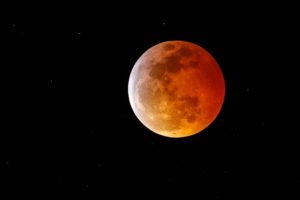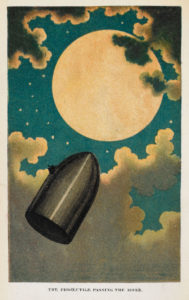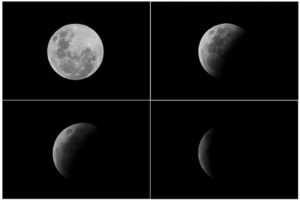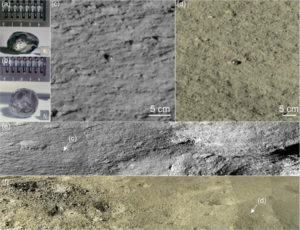-
Space and Astronomy
- Mars: Just the Beginning? – Lesson
- Mars: Just the Beginning? – Quiz
- Six Billion ‘Earth-like’ Planets in the Milky Way Galaxy? – Lesson
- Six Billion ‘Earth-like’ Planets in the Milky Way Galaxy? – Quiz
- Did NASA Scientists Find Another Universe? – Lesson
- Did NASA Scientists Find Another Universe? – Quiz
- A New Planet Was Discovered – And Old Theories Must Change – Lesson
- A New Planet Was Discovered – And Old Theories Must Change – Quiz
- SpaceX Completes First Civilian Trip to Space – Lesson
- SpaceX Completes First Civilian Trip to Space – Quiz
- First Movie Filmed in Space Successful – Lesson
- First Movie Filmed in Space Successful – Quiz
- James Webb Telescope Heads to Deep Space – Lesson
- James Webb Telescope Heads to Deep Space – Quiz
- A Lot Is Happening on and Around the Moon – Lesson
- A Lot Is Happening on and Around the Moon – Quiz
- First-Ever Picture Taken of the Milky Way’s Black Hole – Lesson
- First-Ever Picture Taken of the Milky Way’s Black Hole – Quiz
- First James Webb Telescope Images Revealed – Lesson
- First James Webb Telescope Images Revealed – Quiz
- Buzz Aldrin Sells Jacket from the Moon Landing – Lesson
- Buzz Aldrin Sells Jacket from the Moon Landing – Quiz
- Humans at Home on the Moon – Could It Really Happen in This Decade? – Lesson
- Humans at Home on the Moon – Could It Really Happen in This Decade? – Quiz
- Winter on Mars – Lesson
- Winter on Mars – Quiz
- Pictures of Mars Show Hidden Figures – Lesson
- Pictures of Mars Show Hidden Figures – Quiz
- Jupiter and Venus Appear to ‘Kiss’ – Lesson
- Jupiter and Venus Appear to ‘Kiss’ – Quiz
- The James Webb Telescope Finds Six Ancient Galaxies – Lesson
- The James Webb Telescope Finds Six Ancient Galaxies – Quiz
- Would an EpiPen Work in Space? – Lesson
- Would an EpiPen Work in Space? – Quiz
- Satellite Spots Earth’s Second Moon? – Lesson
- Satellite Spots Earth’s Second Moon? – Quiz
- Space Mining – The Race is On and China is Leading – Lesson
- Space Mining – The Race is On and China is Leading – Quiz
- How Did Gold and Platinum Arrive on Earth – Lesson
- How Did Gold and Platinum Arrive on Earth – Quiz
-
The Environment
- Red Tide: No Fun in the Florida Sun – Lesson
- Red Tide: No Fun in the Florida Sun – Quiz
- Leaded Gas Eradicated from the World, Says United Nations – Lesson
- Leaded Gas Eradicated from the World, Says United Nations – Quiz
- COVID Plastic Waste: A Big Problem for Oceans – Lesson
- COVID Plastic Waste: A Big Problem for Oceans – Quiz
-
Archaeology and Paleontology
- Ancient Human Species Discovered – Lesson
- Ancient Human Species Discovered – Quiz
- Biblical City of Sodom Found in the Jordan Valley? – Lesson
- Biblical City of Sodom Found in the Jordan Valley? – Quiz
- Antarctic Explorer’s Ship Found After a Century – Lesson
- Antarctic Explorer’s Ship Found After a Century – Quiz
- Newly Found Diary Shows How Ancient Egyptians Built the Pyramids – Lesson
- Newly Found Diary Shows How Ancient Egyptians Built the Pyramids – Quiz
- Study Shows ‘Apocalyptic Dust’ Might Have Killed the Dinosaurs – Lesson
- Study Shows ‘Apocalyptic Dust’ Might Have Killed the Dinosaurs – Quiz
-
Technology
- 3 Reasons to Protect Your Online Privacy – Lesson – VIDEO
- The Rise of Deepfakes – Lesson
- The Rise of Deepfakes – Quiz
- A New Mayflower Voyage, Captained by AI Technology – Lesson
- A New Mayflower Voyage, Captained by AI Technology – Quiz
- The Latest Supercomputer Is Breaking Speed Barriers – Lesson
- The Latest Supercomputer Is Breaking Speed Barriers – Quiz
- LNGenZ Survey: What is the Greatest American Invention? – Lesson
- LNGenZ Survey: What is the Greatest American Invention? – Quiz
- School and ChatGPT – Is it Cheating? – Lesson
- School and ChatGPT – Is it Cheating? – Quiz
- Artificial Intelligence Gets an Upgrade? – Lesson
- Artificial Intelligence Gets an Upgrade? – Quiz
- Scientists Plan to Bring the Dodo Bird Back from Extinction – Lesson
- Scientists Plan to Bring the Dodo Bird Back from Extinction – Quiz
- Is There Too Much Technology in Education? – Lesson
- Is There Too Much Technology in Education? – Quiz
- AI Coming to a Keyboard Near You – Lesson
- AI Coming to a Keyboard Near You – Quiz
-
Mind and Body
- Teen Scientist’s Invention Mixes Music with Mental Health – Lesson
- Teen Scientist’s Invention Mixes Music with Mental Health – Quiz
- Man Receives First Pig Heart Transplant – Lesson
- Man Receives First Pig Heart Transplant – Quiz
- Sniffing Out the Truth About Smells – Lesson
- Sniffing Out the Truth About Smells – Quiz
- The Power of Playtime – Lesson
- The Power of Playtime – Quiz
- Is Language Getting More Emotional? – Lesson
- Is Language Getting More Emotional? – Quiz
- Scientists Say Household Chores Help Kids’ Brains – Lesson
- Scientists Say Household Chores Help Kids’ Brains – Quiz
- Transplant of Pig Kidney Into a Human Successful So Far – Lesson
- Transplant of Pig Kidney Into a Human Successful So Far – Quiz
- The Lack of a College Degree Is Shortening Lifespans – Lesson
- The Lack of a College Degree Is Shortening Lifespans – Quiz
-
Flora and Fauna
- Dogs Can Tell When Humans Make a Mistake, Says Study – Lesson
- Dogs Can Tell When Humans Make a Mistake, Says Study – Quiz
- Jonathan: The World’s Oldest Living Tortoise – Lesson
- Jonathan: The World’s Oldest Living Tortoise – Quiz
- The Monarch Butterfly Makes a Surprise Return – Lesson
- The Monarch Butterfly Makes a Surprise Return – Quiz
- Bat Falcon Spotted in the United States for the First Time – Lesson
- Bat Falcon Spotted in United States for the First Time – Quiz
- Charles Darwin’s Notebooks Mysteriously Returned after 20 Years – Lesson
- Charles Darwin’s Notebooks Mysteriously Returned after 20 Years – Quiz
- Six Endangered Red Wolf Pups Born in Wildlife Refuge – Lesson
- Six Endangered Red Wolf Pups Born in Wildlife Refuge – Quiz
- Scientists Record Never-Before-Heard Whale Call – Lesson
- Scientists Record Never-Before Heard Whale Call – Quiz
- Underwater Meadow Gets Credit as the World’s Largest Living Plant – Lesson
- Underwater Meadow Gets Credit as the World’s Largest Living Plant – Quiz
- Scientists Trying to Bring the Tasmanian Tiger Back from Extinction – Lesson
- Scientists Trying to Bring the Tasmanian Tiger Back from Extinction – Quiz
- Jurassic Era Insect Found at Arizona Walmart – Lesson
- Jurassic Era Insect Found at Arizona Walmart – Quiz
- The Comeback of the Nearly Extinct Earless Lizard – Lesson
- The Comeback of the Nearly Extinct Earless Lizard – Quiz
- A Strange Golden Orb Found on the Ocean Floor Is Alive! – Lesson
- A Strange Golden Orb Found on the Ocean Floor Is Alive! – Quiz
- Peanut: The Pet Chicken With a World Record – Lesson
- Peanut: The Pet Chicken With a World Record – Quiz
-
Mathematics
- Metric vs. Imperial: A Weighty Debate in Britain – Lesson
- Metric vs. Imperial: A Weighty Debate in Britain – Quiz
- The Abacus is Helping Kids Master Math Skills – Lesson
- The Abacus is Helping Kids Master Math Skills – Quiz
- Retired Engineer Discovers ‘Einstein’ Shape – Lesson
- Retired Engineer Discovers ‘Einstein’ Shape – Quiz
A Lot Is Happening on and Around the Moon – Lesson

(Photo by Rich Polk/Getty Images)
From collisions to discoveries, and more!
The Moon, with a diameter of roughly 2,160 miles, is the Earth’s only natural satellite. For years, scientists have studied it, as it is one of the most visible and recognizable objects in the sky. Lunar activity is captured by satellites that orbit the moon continuously. Recently, the celestial body collided with something floating around in space. The impact marked the first time a manmade object accidentally struck the Moon. But that isn’t all that’s going on up there.
Manmade Junk Collides with the Moon
On Friday, March 4, 2022, a rocket booster is believed to have crashed into the surface of the Moon after floating in space for nearly eight years. Scientists are not entirely sure that contact was made with the Moon, as the orbiting satellites have not yet passed by the area assumed to be hit. It could take weeks or even months before they know for sure.

The rocket was first thought to be part of the SpaceX Falcon 9 craft, launched by Elon Musk and his team in 2015. Later, it was said to be part of the Chang’e 5-T1, a Chinese rocket launched in 2014, but China denied the rocket was theirs.

Illustration to From the Earth to the Moon by Jules Verne, 1877. (Photo by Fine Art Images/Heritage Images/Getty Images)
The collision likely made a crater approximately 65 feet in diameter, but this cannot be proven until scientists can look at satellite images.
NASA Is Flying Names Around the Moon
How cool would it be to have your name flown around the Moon? NASA is offering this free service to the public. Those who sign-up will have their names added to a flash drive that will be taken onto the Orion capsule as part of the Artemis 1 mission.
In addition, each participant will receive a virtual boarding pass that will contain their name and details about the flight. There will be no human onboard the Orion capsule. This flight is a test meant to determine if humans can be taken to the Moon on future flights. Though no exact date has been released, the flight could occur as soon as May.
Members of the public can sign-up to fly their names around the moon here.
US Military Plans to Extend its Space Awareness

(Photo by Don Arnold/Getty Images)
The US space mission currently extends 22,000 miles above Earth. The military would like to extend that range by ten times, to explore deeper into cislunar space (the area between the Earth and the moon). The US Air Force Research Laboratory plans to launch a Cislunar Highway Patrol System (CHPS), starting with a satellite that will travel more than 270,000 miles from Earth, to the far side of the moon.
Brian Weeden, the director of program planning for the Secure World Foundation, said: “It’s the first step for them to be able to know what’s going on in cislunar space and then identify any potential threats to US activities.”
The satellite will provide the military with information that they would not have access to otherwise.
Two Glass Spheres Found on the Moon

Glass globules seen on the moon (Image by Zhiyong Xiao, et al., published in scientific journal Science Bulletin)
Two glass spheres between 0.59 and 0.79 inches across were discovered by China’s Yutu 2 rover. It is likely that these globules were formed by relatively recent meteor impacts. They are made from a volcanic rock called anorthosite, which is rich in feldspar – a group of minerals that contains calcium, sodium, or potassium.
Scientist Zhiyong Xiao and his team are thrilled about the insight the glass spheres could bring concerning the Moon’s history. The discovery will help to guide future lunar missions to put humans on the Moon for longer amounts of time.